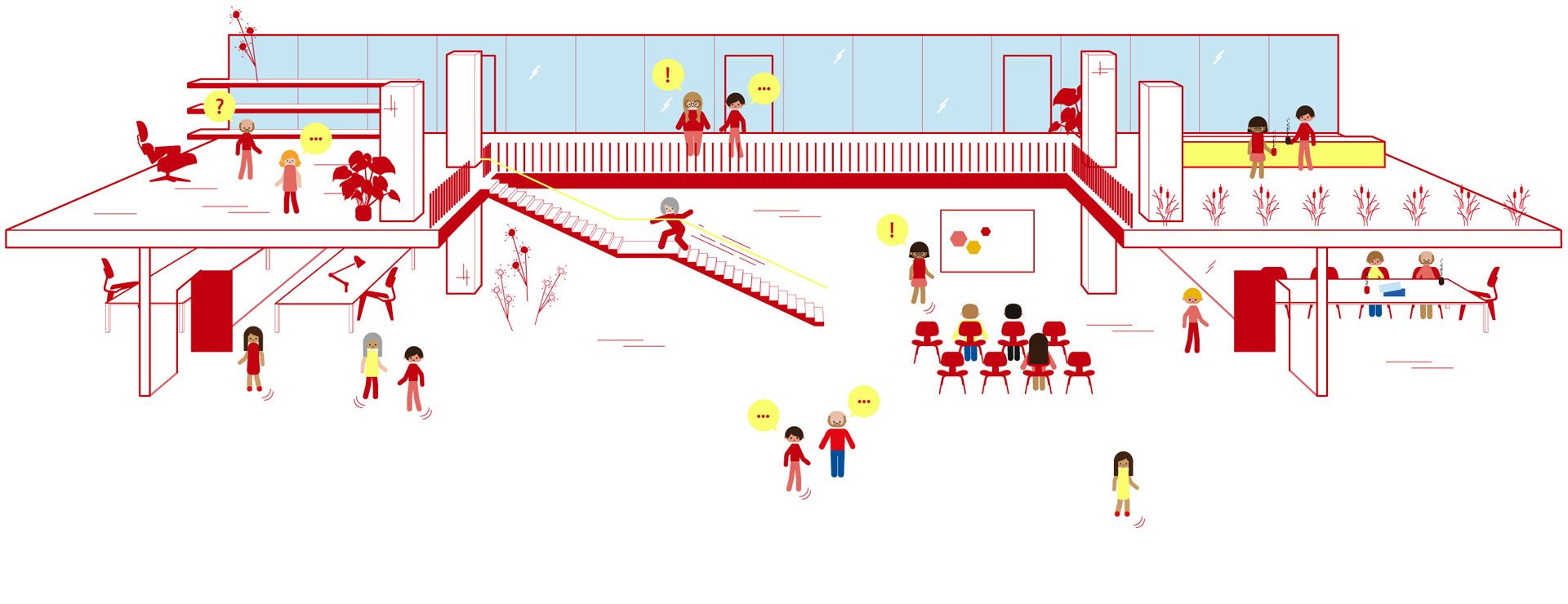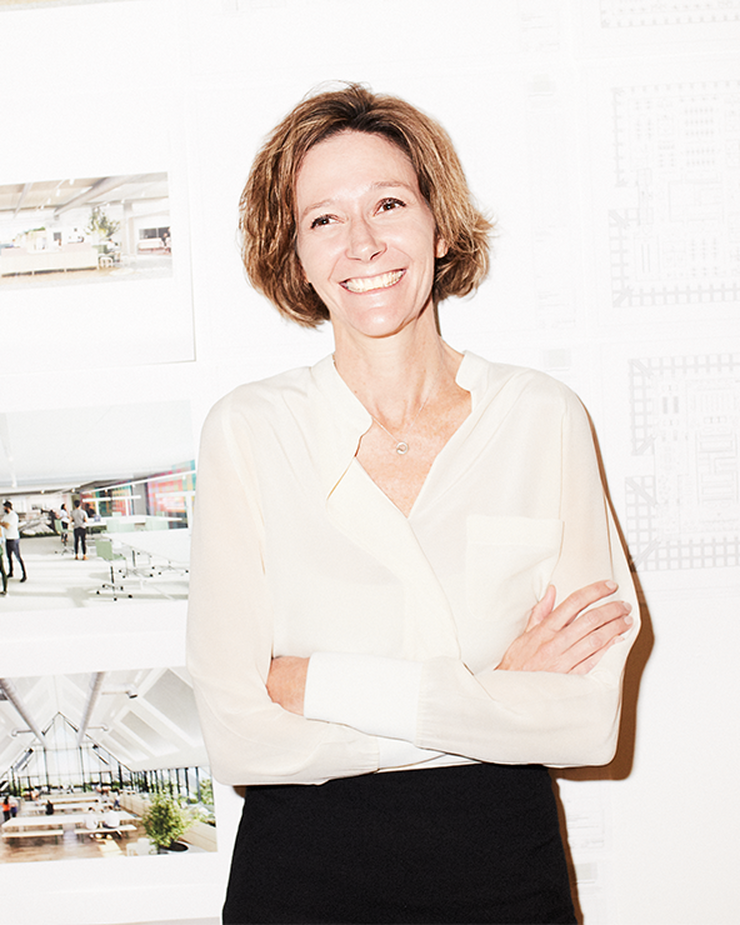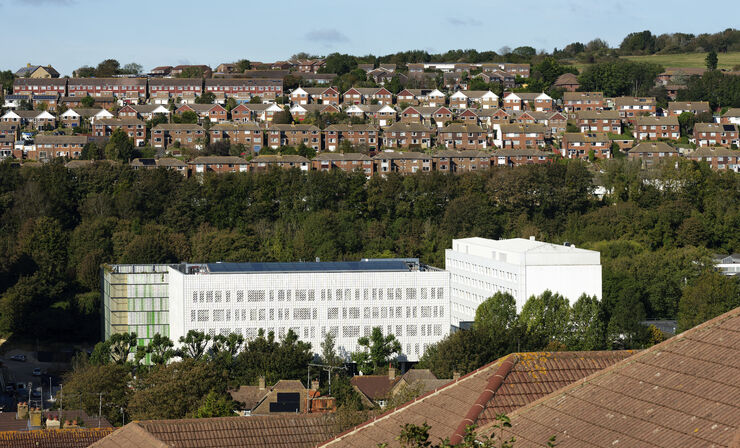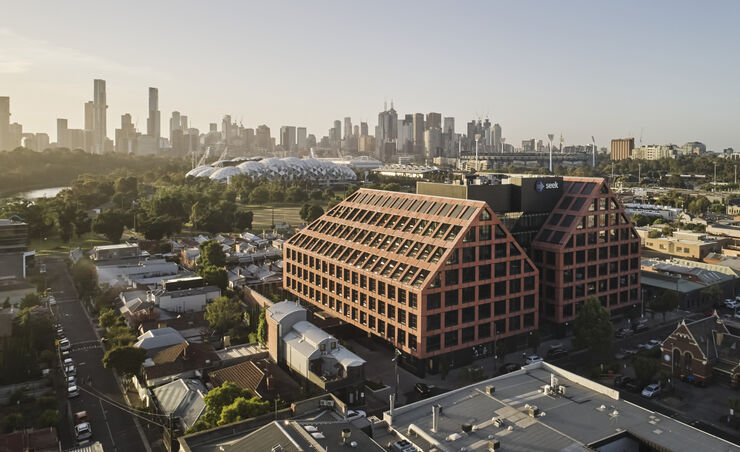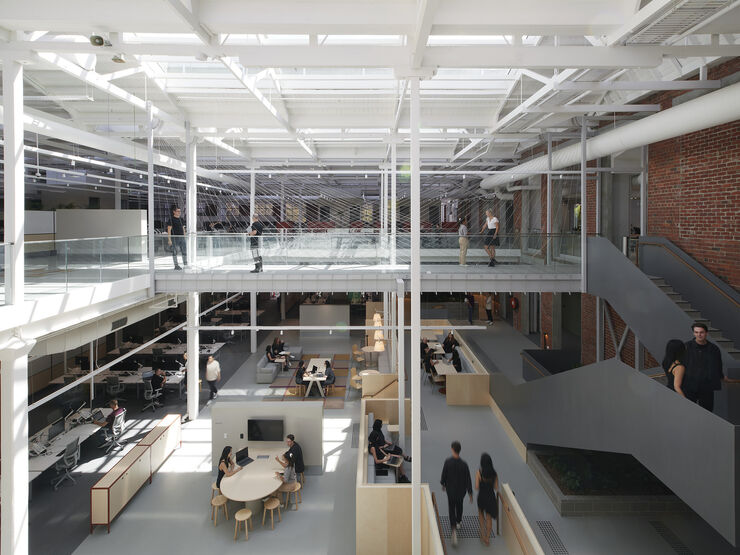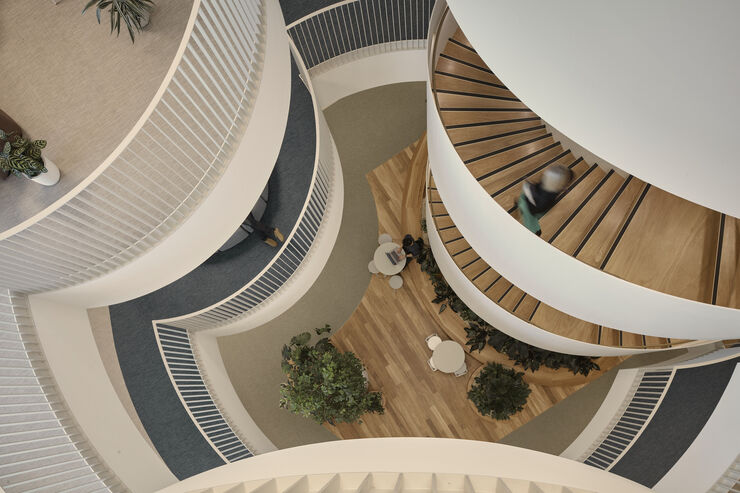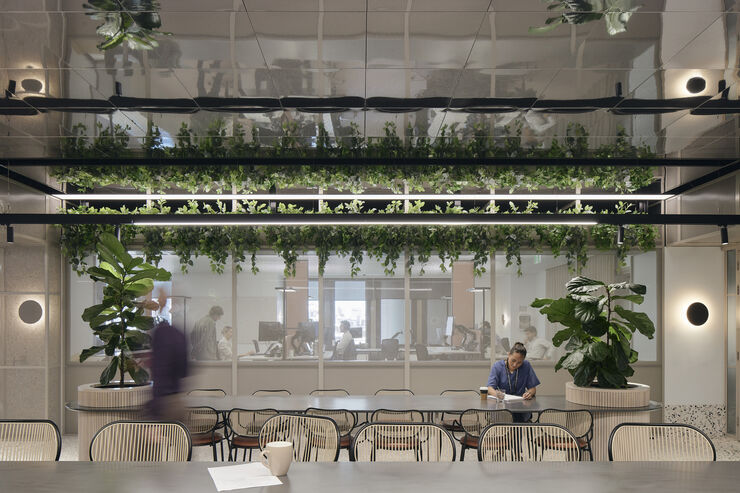Transcript
Evodia:
I’m Evodia Alaterou. I’m a principle and design strategist at Hassell. Even when I was at architecture school and I was learning how to be a designer, I found the briefs that they gave us quite frustrating because it didn’t give me enough information about who we’re doing this for and why we’re designing. So I always wanted to know more about the people. So as I grew up in my career workplace became a natural place for me to end up in because workplace is all about people. Workplace is all about motivating people. A lot of people’s identity is wrapped up in what they do, and it gives people a sense of contribution and a sense of belonging and being part of something bigger. So, there’s a lot of emotion and a lot of psychology tied up in the work that people do and why they work.
Of course, it makes sense that the places that they go to do these activities are really important also. And I think that all the research and all of the thought that goes into creating good workplaces, great workplaces is really important. In fact, if anything, we probably need to give it a little bit more thought and interrogate it a little bit more to make sure that we get it right.
I did one of those little Google experiments, when you go onto Google and you type in something and you check to see how it auto-fills it. So I typed in open plan and it came up with the words, “I hate my open plan.” So, that was the number one thing that Google auto-filled it with. And of course there was pages and pages and pages. It’s interesting to see that this conversation that has been going for a really long time is still very much alive.
We haven’t gotten to the point where we’ve resolved workplace. To help explore this topic around workplace, I am joined by professor Andrew Westin who’s from the University of Melbourne, the Melbourne School of Engineering. Andrew is a professor in the department of infrastructure engineering and is also the director of the infrastructure programme that the Melbourne School of Engineering is running at the moment.
We want to explore this topic around the academic workplace, kick around a few of the ideas that we have come upon over the years that we’ve worked together. So, Andrew, thank you. Thank you for talking to me today.
Andrew:
Thanks, Evodia. It’s the biggest investment we have actually as a university is in the people. So your interest in people is one of our key interests. It’s all about enabling people to do their best.
Evodia:
You fell into workplace strategy and design. Do you want to tell us a little bit about your own background and your own story and how you got to where you are today?
Andrew:
I’m an engineer obviously working for the School of Engineering, but I’m a water engineer. So my academic career has mainly been around research in water resources and how the landscape works with water and that sort of thing. But we have a big team of people in our research group.
Evodia:
When the school of engineering set its strategic direction for 2025, it recognised that work place itself is going to need to change and be quite different. The environment, not just workplace, but the overall environment that the school needed to provide or needs to provide for its people and its collaborators in the industry and so forth. It needs to be different, right?
Andrew:
Yup.
Evodia:
And one of the environments is the workplace environment.
Andrew:
Early on in the infrastructure strategy for the School of Engineering, the Dean was looking for ways of just testing out some ideas. So not committing to any particular changes, but testing out ideas to see if we could do things differently. And there was a fair bit of opposition. I perhaps opened my mouth a little too widely and said that if we’re going to test these things out, we might as well test the boundaries. So we want sometimes things to fail. So to give a sense of scale, we provide work points, desks for about 1500 people at the moment, across the faculty. We have lots of post docs and PhD students on the more academic side who had really been accommodated in not very good quality work space over the years, often with extremely limited meeting facilities, not even being at having a place to go and make the personal phone call that you might want to make or those sorts of things.
So in one sense, we’ve served our academics really quite well. They’ve got their own space that they can own and make their own. It’s important to come back to the 85% of people though in this debate, because most of our other staff haven’t really had that privilege. And I’m not saying everyone should be equal in this because we all know different people have different requirements, different people are different stages in their career. And that sort of thing, different levels of busy-ness. We’ve got to remember, there’s the people that spend more time on research. And some of those people are just the desk and the lab is their main work environment. For our professional staff, the desk, or [inaudible 00:05:37] workspace is probably where they spend most of their time. Over the next few years through this programme where essentially renewing all of that workplace.
And the school is moving to a model where we’re quite strongly co-located with industry partners. It’s a big change in strategy. It’s not just internal strategy, but it’s how we interact with the wider world as well. And we just couldn’t continue with the quality of workspace we had. That was an important driver in thinking about, through some of the design things that you are closely involved to design principles. I don’t know whether you use design principles on every project you do or …
Evodia:
We do. It’s essential. Yeah.
Andrew:
I would have thought so.
Evodia:
It’s absolutely essential. You’ve seen them in action now, haven’t you? So we did the work to establish what those principles are and how they relate to the strategy for MSE 2025. And those are the guiding lights, the beacons that guide the projects all the way through. So if you’re going to start a design process, you look at what are the principles, what are the main things that we want to achieve here? And then all the decisions that are made along the way, come back to those principles.
Andrew:
Yeah. Yeah. They’ve been been super important in the conversations because they’re an anchor that you can hang on to, to keep you going in the right direction.
Evodia:
There was a lot of work through the engagement and the design, and then a lot of work through the occupation to see what’s happening. To see what’s working, what’s not, seeing what’s broken, what’s breaking and the opportunity to test something before going and delivering thousands of square metres of something.
Andrew:
Well, we broke a few things, which was good.
Evodia:
Well, and that’s good.
Andrew:
We learned things.
Evodia:
Yeah, definitely. So tell us a bit about your experiences in the space lab.
Andrew:
The area seats about 50 people, it’s divided up into pods. And so we had different teams in different work neighbourhoods. Noise is probably one of them. We had mixture of academic staff, people like myself, and we had our HR team in there for some of the time. We had our finance team in there for some time, sitting next to research teams. Yeah. HR and finance, of course, very transactional. They’re on the phone all the time. Of course they’re noisy in doing that. Sitting right next to a very quiet research group. That was one of the things. So the other distraction thing, of course that came up was the visual one, which I think was a surprise for you, you’ve said in the past.
Evodia:
Sitting at a desk and having movement in your peripheral vision. And we’re so used to it, it happens every day. I don’t even think about it. And I didn’t appreciate that others would really struggle with that. And then technology is the big one.
Andrew:
If it doesn’t work, of course everyone hates it.
Evodia:
Yeah. It’s not particularly helpful when you have a bunch of individuals who are prepared to give it a go and then the technology doesn’t allow them to give it a go. Yeah. Because students, demographics have changed a lot and students aren’t there Monday to Friday nine to five, they work, they’ve got other commitments and other things going on. So that’s all adding into this mix of productivity. Right? Because you’ve got to teach to more students in more different ways and still deliver an excellent outcome at the end of it.
Andrew:
Yeah. And it means that the more senior people, if you like, or the people who are in the ongoing teaching type roles, are very mobile in terms of where they’re working, not in their office all the time. And when you walk around our workspaces, how often do you see people at the desk?
Evodia:
That’s true. That’s true. And it’s interesting when you look at formal utilisation studies of university faculty workspace, it’s very under utilised. There’s very often that people are away more often than there.
Andrew:
And so they have to be really efficient when they’re there. Maybe you can achieve that in different ways. We do tend to have a lot of the argument being about the academic office.
Evodia:
That’s one thing that we experienced a lot, in all of the briefing that we’ve done is that often the academics come in with the agenda and the agenda is, that I need to make it as clear as possible as many times as possible that I demand an office. And even it felt at times, even when we then did give people offices or the option of an office, the conversation was still not quite resolved enough.
Andrew:
So it’s a little bit of people being set in their ways, I think. People have had an office for a long time. It’s worked, they’re busy. They don’t really want to change. Whether it could be better, that’s the question we should be asking.
Evodia:
Yeah. Yeah. So these are all challenges. These are all the things that we’re facing in workplace design and academic workplace design. I think that’s probably one of the greatest learnings from that whole process altogether, all up is that it’s not, it’s not a fixed environment. It’s not fixed spatially, because we could move things around physically and it’s not fixed in how it’s occupied either. So groups and people had control over how they wanted to occupy the space and giving people that freedom and that control and that permission was quite successful in many ways.
Andrew:
It’s become one of our principles for managing space. Within reason the group can decide how they will operate the space.
Evodia:
A lot of other organisations, including universities, going with the approach of we are going to go to an activities based environment and we need to do X, Y, and Z to get us there. And that’s it, that’s the answer. Whereas what you guys learned through that process is that not having such a definitive approach is actually much more useful in getting people along, getting people interested, motivated.
Andrew:
And if you give people autonomy, they’ll probably find a better solution than what you were going to impose on them.
Evodia:
Yeah, exactly. So the workplace is like a framework, a physical framework, and then people within their groups and within their teams, they make those adjustments themselves. So they choose how they want to live and operate in that space.
Andrew:
Yeah. In the process approach, one of my favourite moments has been when various people in my own group have said, “I was really not looking forward to this move. I’ve heard how bad these sort of places are for work.” And now I think everyone’s enjoying the space. Some people that work out in the corporate sector and have said, a lot of the open plan out in the corporate sector that they’d worked in, actually, wasn’t very good to work in and they think this is the best work place they’ve worked in over their careers.
Evodia:
After the first cohort had gone through and we did the evaluation, the focus group workshops afterwards, one of the occupants who’s an academic said he thought he was going to hate it. And then he ended up absolutely loving it.
Andrew:
Yeah.
Evodia:
Absolutely loved being in the open plan and having access to all of the facilities, all of the rooms, having his group with him. So it’s great when people see that open plan is not about robbing you of your joy and your ability to be productive. But it’s actually there as a tool to help you to be more connected and to be more productive with your people, provided that everything else is in place so that you can do your quiet focus work, and you can do your social stuff and you can mark your exam papers and store your books and so forth.
In a nutshell, few sentences, what advice would you give to others in your position who are embarking on new workplaces in the universe, in the world of the university workplace? What are your three top tips?
Andrew:
Well, working out your strategy and having those design principles that align with your strategy is a critical thing. Having the conversations. The conversations are long. Sometimes they feel like they’re going nowhere, but you have to have the conversations and getting as many people as you can to look at different things. Now, whether that’s by running a trial or going and looking at other workplaces, whatever it is, get people to open their minds to the broader range of possibilities. We’ve been generously hosted by a number of other universities around Australia, going and looking at their newer buildings and finding out what’s worked for them and what hasn’t worked for them. And over this programme, we’ve gone and looked at various commercial workplaces as well. Those trips have been really valuable, and we’ve always tried to take colleagues along with us. So it’s not just the infrastructure team.
Evodia:
You know what? That’s a beautiful full circle. The reason why I am so interested in workplace and have been working in it for so long is because it’s all about people. Right? And what you’ve just said, your top tips, focus on the people because it’s for them. And it’s about them. Have the conversation, spend time with them, show them, teach them, help them along the way.
That’s wonderful. Thank you, Andrew. That was really great conversation. And thanks for taking the time and sharing your thinking and your learnings with us.
Andrew:
Thanks, Evodia.
Evodia:
I’m Evodia Alaterou and this is Hassell Talks. Thanks for listening.
